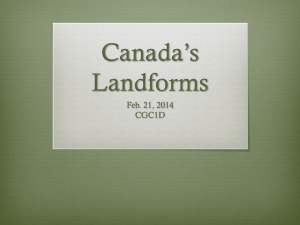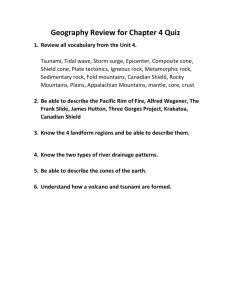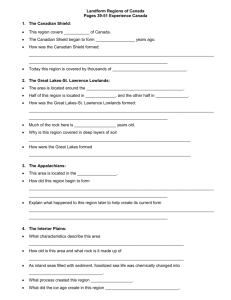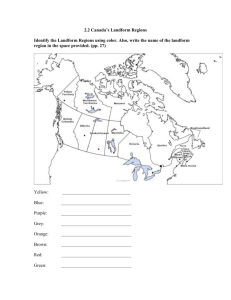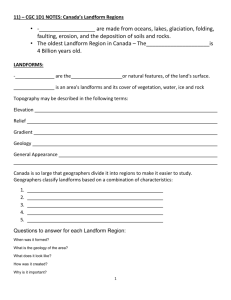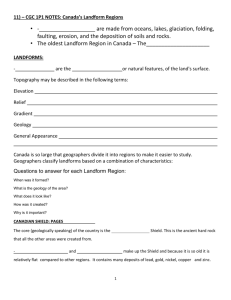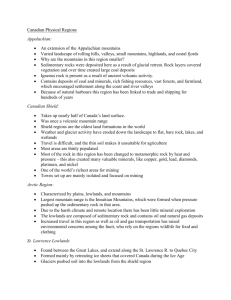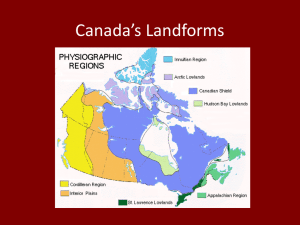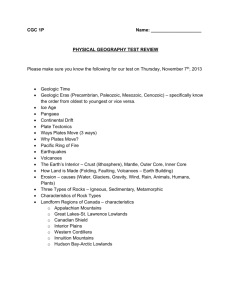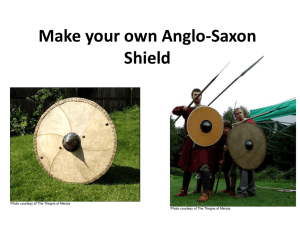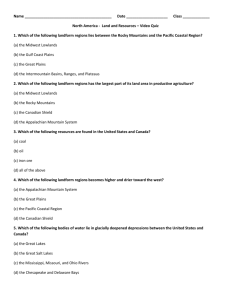Chapter 10 Landform Connections NotesFrame
advertisement
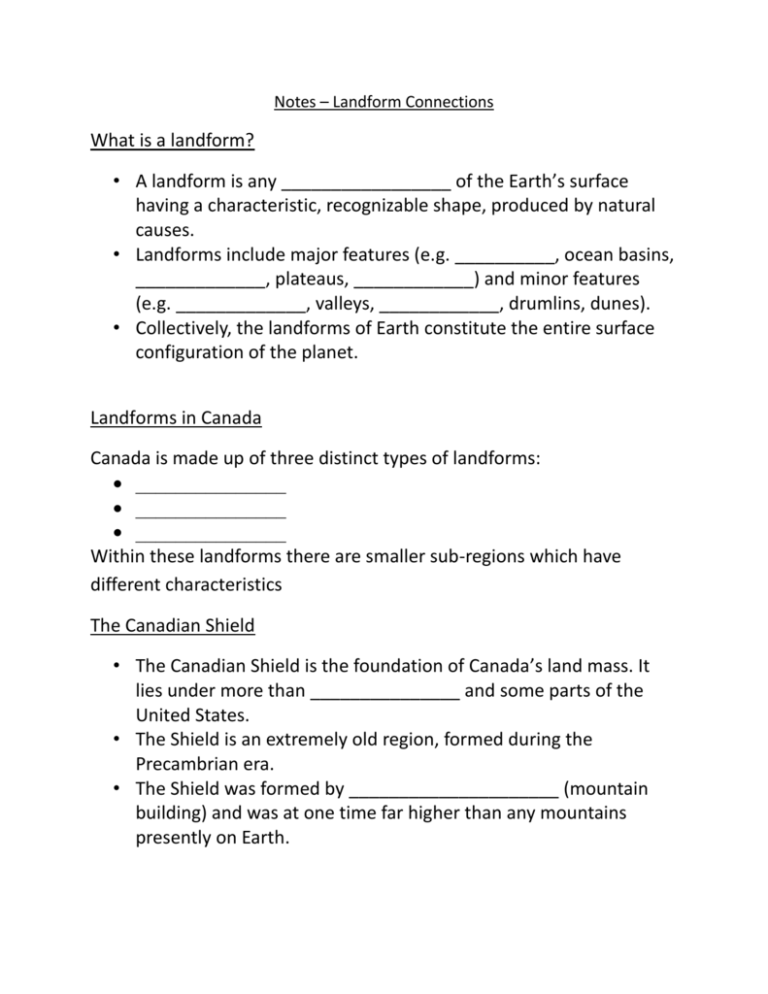
Notes – Landform Connections What is a landform? • A landform is any _________________ of the Earth’s surface having a characteristic, recognizable shape, produced by natural causes. • Landforms include major features (e.g. __________, ocean basins, _____________, plateaus, ____________) and minor features (e.g. _____________, valleys, ____________, drumlins, dunes). • Collectively, the landforms of Earth constitute the entire surface configuration of the planet. Landforms in Canada Canada is made up of three distinct types of landforms: _______________ _______________ _______________ Within these landforms there are smaller sub-regions which have different characteristics The Canadian Shield • The Canadian Shield is the foundation of Canada’s land mass. It lies under more than _______________ and some parts of the United States. • The Shield is an extremely old region, formed during the Precambrian era. • The Shield was formed by _____________________ (mountain building) and was at one time far higher than any mountains presently on Earth. • Over its long history, the shield was worn down by ______________, and now is nearly flat, with rounded hills of rock. • The Shield is also made up of many different minerals and metals, which were formed in the igneous and metamorphic rock of the Shield. • Due to these mineral deposits, many towns and cities have been built on top of it (ie. ________________________.) • The Shield __________________________________________ • ______________________________________________________ _____. As well, water does not drain well as the Shield is rock, and impervious to water. The Lowlands There are three lowland regions in Canada, surrounding the Shield: _________________________________ _________________________________ _________________________________ The bedrock of these regions was formed by the eroded material of the shield being ___________________________which covered parts of Canada. These sediments were gradually compressed over time into rock. The Interior Plains th • This region stretches from the 49 parallel __________ _________________________(about 2700 km) • At the southern point, the plains stretch 1300 km east to west, but are only about 275 km wide in the Northern regions. • The soil that has developed in this region is fertile and deep, and has allowed the growth of many crops in the Prairie region (Canada’s “breadbasket”) • The region was also shaped by _______________, and lakes such ______________________ were formed as a result of glacial forces. • Great Lakes – St. Lawrence Lowlands • __________________________, this region is made up of two different parts, which are intersected at one point (near Kingston) by the Shield. • South of this point, the Great Lakes lowlands are found. The region is _____________________________________ ________________________________. The Great Lakes were themselves gouged out of the landscape by glacial movement. • The St. Lawrence lowlands were formed as a result of tectonics, in a process called_______________. Two plates moving apart left a valley in between, which became flooded with water. The ____________________ is a result of this process. • The ________________________________________ ___________________________________________. • In addition, these factors have allowed the growth of large cities, which are well situated for trade on the major waterways. • About 50% of Canada’s population live in this region, and 70% of the countries manufacturing takes place here. The Highlands • Canada also has three highland areas to the east, north and west of the Shield and lowland areas. • The Appalachians • The Innuitians • The Western Cordillera • Each of these three areas has a different geologic history and appearance. The Appalachian Mountains • These mountains are the oldest highland region in Canada, formed about ____________________ years ago. • _______________________ forced the layers of rock upwards as the North American plate collided with the plates of Europe and Africa during the formation of Pangaea. • Millions of years of _______________has worn the peaks of the Appalachians down into _______________________. • During the last ice age, the weight of the glaciers on the region forced the plate downwards, and allowed the flooding of the lower areas by the ocean. As a result, the coastline of the area is dotted with deep inlets. Innuitian Mountains • These mountains were formed in the _______________, by the northward movement of the North American plate. • Since these mountains are_______________ than the Appalachians, they have not been worn down as dramatically. • Due to their location and climate, the mountains are _____________________as trees cannot survive on them. • Mineral deposits in this region have been found, but are not commercially feasible, due to the remoteness of their location. Western Cordillera • This region, on the Western coastline of Canada, is made up of ____________________________. These features tell us that the mountains here are still ______________________. • The interaction of the Pacific and North American plate led to the uplifting of the region into several mountain ranges. Misconceptions about the Cordillera Region • The mountains in this area run in a North-South direction. There are three distinct and different mountain ranges in this region: • _________________________________ _________________________________ • _________________________________ ________________________________ • _________________________________ ________________________________ • The Western Cordillera is therefore not only the Rocky Mountains, but several other ranges.
